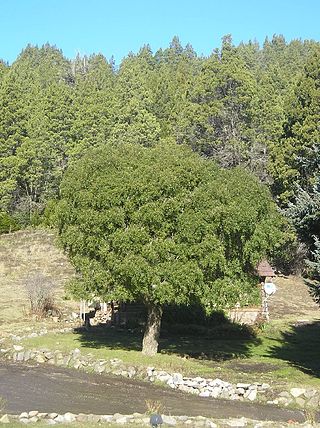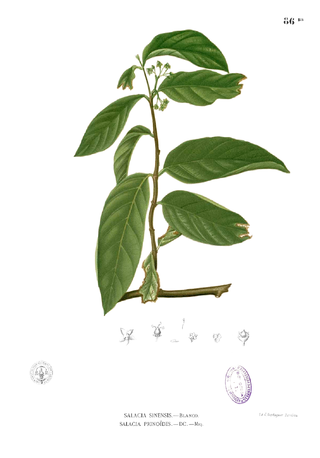
The Celastraceae are a family of 98 genera and 1,350 species of herbs, vines, shrubs and small trees, belonging to the order Celastrales. The great majority of the genera are tropical, with only Celastrus, Euonymus and Maytenus widespread in temperate climates, and Parnassia (bog-stars) found in alpine and arctic climates.

Celastrus, commonly known as staff vine, staff tree or bittersweet, is the type genus of the family Celastraceae; it contains over 40 species of shrubs and vines, which have a wide distribution in East Asia, Australasia, Africa, and the Americas.
Phelline is a genus of shrubs and the sole member of the family Phellinaceae, a family of flowering plants endemic to New Caledonia. It is placed in the order Asterales and is related to two other small plant families: Alseuosmiaceae and Argophyllaceae. It contains ten species.

Euplassa is a genus of flowering plants in the protea family. It is native to tropical South America, including Bolivia, Brazil, Colombia, Ecuador, French Guiana, Guyana, Peru, Suriname, and Venezuela.

Gymnosporia is an Old World genus of plants, that comprise suffrutices, shrubs and trees. It was formerly considered congeneric with Maytenus, but more recent investigations separated it based on the presence of achyblasts and spines, alternate leaves or fascicles of leaves, an inflorescence that forms a dichasium, mostly unisexual flowers, and fruit forming a dehiscent capsule, with an aril on the seed. It is dioecious, with male and female flowers on separate plants.

Lophopetalum is a genus of plants in the family Celastraceae.

Maytenus is a genus of flowering plants in the family Celastraceae. Members of the genus are distributed throughout Central and South America, Southeast Asia, Micronesia, and Australasia, the Indian Ocean and Africa. They grow in a very wide variety of climates, from tropical to subpolar. The traditional circumscription of Maytenus was paraphyletic, so many species have been transferred to Denhamia and Gymnosporia.

Salacia is a genus of plants in the family Celastraceae. They are woody climbers naturally found in tropical regions.
Ludwig Eduard Theodor Lösener was a German botanist who collected widely in the field in Germany: Amrum island (1912), the Alps, the Black Forest, Bavaria, Rügen island and Tyrol in modern Austria. His speciality was the Aquifoliaceae of the world. He also studied cultivars of Ilex species. His name is often spelled as 'Loesener' in English sources.

Elaeodendron is a genus of flowering plants in the staff vine family, Celastraceae. It includes 39 species native to the tropics of the Americas, sub-Saharan Africa, Asia, Australia, and the South Pacific.

Boesenbergia is a genus of plants in the ginger family. It contains more than 90 species, native to China, the Indian Subcontinent, and Southeast Asia.

Crossopetalum, commonly known as Christmas-berries or maiden berries, is a genus of flowering plants in the family Celastraceae. It comprises about 30-40 species.
Tristemonanthus is a genus of flowering plants belonging to the family Celastraceae.
Thyrsosalacia is a genus of flowering plants belonging to the family Celastraceae.

Loeseneriella is a genus of flowering plants belonging to the family Celastraceae.
Campylostemon is a genus of flowering plants belonging to the family Celastraceae.
Elachyptera is a genus of flowering plants belonging to the family Celastraceae.
Pristimera is a genus of flowering plants belonging to the family Celastraceae.
Salacighia is a genus of flowering plants belonging to the family Celastraceae.










